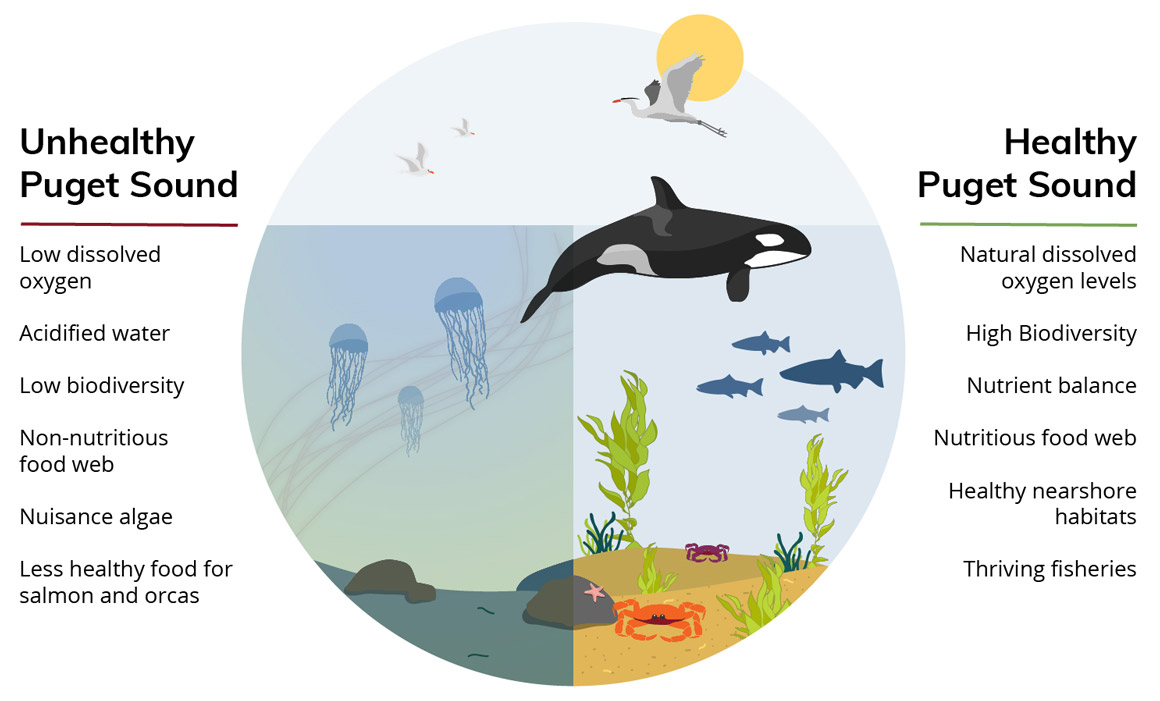Special Announcement: The Stormwater Strategic Initiative Leads (SILs) solicitations for competitive Request for Proposals (RFPs) have been released. Click here to learn more
Nutrients such as nitrogen and phosphorus are essential building blocks for all living things and are necessary for a productive and healthy ecosystem in terrestrial and aquatic systems. In nitrogen-limited systems, such as the marine waters of Puget Sound, excessive abundance of nitrogen from human sources can lead to changes in marine life productivity and low dissolved oxygen that exacerbate already hypoxic areas due to inter-annually variable ocean and climate conditions. To reduce the degradation of marine water quality due to cumulative impacts of regional human-related (anthropogenic) nutrient loads and increase the Sound’s resilience to climate change impacts, excess human inputs of nitrogen must be reduced within the Puget Sound basin.
You can learn more about Nitrogen in Puget Sound by visiting this Story Map!
Why is Marine Water Quality Important?

Sunset over Bellingham Bay in northern Puget Sound with Lummi Island in the background. Photo Credit: US EPA
Nitrogen loads from regional anthropogenic sources include: wastewater discharges, stormwater runoff from urbanized areas, agricultural activities without best management practices, and loss of natural ecosystem functions that attenuate nitrogen in watersheds. Without strategic intervention to reduce the cumulative burden of human nitrogen sources, continued and increasing nitrogen loads from a rapidly growing regional population will further degrade marine dissolved oxygen (DO), especially in biologically important inlets and bays. Excess anthropogenic nitrogen also influences other indicators of marine water quality health, including:
- Increased local acidification conditions
- Changes to marine benthic community structure and diversity
- Changes to micronutrient availability that may lead to increased occurrence and duration of harmful algal blooms
- Impairments to eelgrass beds, a critical habitat for aquatic species in Puget Sound
Better managing our regional anthropogenic nutrient loads is a key part of supporting healthy marine water quality and ensuring Puget Sound aquatic species and ecosystems are healthy, robust, and resilient.
The Marine Water Quality Vital Sign goal is to limit cumulative anthropogenic contributions of nitrogen so they do not cause more than 0.2mg/L reductions in DO levels anywhere in Puget Sound. Any further loads of anthropogenic nitrogen that causes further DO depletion is considered excess nitrogen.

To meet marine water quality goals in Puget Sound, anthropogenic nitrogen reductions are critically needed from domestic wastewater treatment plants (WWTPs). The Department of Ecology estimates that about 67% of anthropogenic nitrogen comes from WWTPs. As a first step, a regulatory framework between Ecology and municipal WWTP NPDES permittees is needed to achieve wastewater nutrient reduction goals. This step is in progress as Ecology led development of the Puget Sound Nutrients General Permit. The first issuance of this permit takes effect on January 1, 2022 and includes requirements for WWTPs to evaluate their current WWTP nutrient loads, optimize operations to reduce nitrogen loads, and plan for future upgrades.
To support the reduction of nitrogen loading from WWTPs, additional funding (e.g. Puget Sound Nutrient Reduction Grants Program) and technical assistance is needed to evaluate and implement innovative nitrogen removal treatment through optimization of existing treatment or wastewater infrastructure improvements. Reducing nitrogen outputs from WWTPs is the single largest step towards achieving marine water quality goals.
To reduce anthropogenic depletion of DO in Puget Sound, point and nonpoint sources of nitrogen in watersheds must also be reduced. During rain events stormwater runoff in urban, suburban and rural environments picks up pollutants and nutrients (e.g. improper storage or application of fertilizers, atmospheric deposition of nitrogen on impervious surfaces, soil erosion, pet and wildlife waste), washing them into storm drains and nearby surface waters. Combined stormwater and sewer systems, as well as cross-connected sewer lines, can result in nitrogen loads that bypass any potential wastewater treatment. It is important to fund, develop, pilot and implement new technologies into existing stormwater facilities that removes or reduces nitrogen in stormwater discharges. Behavior change and social marketing campaigns, such as Poop Smart, can also inform the public on the issues and spur corrective actions.
Excess nitrogen in runoff also comes from agricultural operations on both small and large scales when agricultural best management practices are absent or poorly maintained. Stormwater runoff from uncovered manure piles, over-application of livestock manure and chemical fertilizers, runoff from animal feeding operations, and direct deposition from pastures or fields used by animals are just some of the contributing factors to increased nutrient loads from agricultural land. Implementation of agricultural BMPs, such as proper manure storage, appropriate and timely application of fertilizers, and restoring and maintaining riparian areas, will help to reduce or eliminate nitrogen loads in agricultural runoff. Increasing financial incentives and leveraging existing fund sources, along with increasing regional capacity to do the work, can help increase the rate of BMP implementation.
Numerous physical, chemical, biological, and hydrologic factors affect the transformation and attenuation of nitrogen and phosphorus in watersheds. These factors working together are defined as the natural nutrient attenuation function of a watershed. Human land use activities that degrade natural nutrient attenuation processes can include: degraded and non-existent riparian areas, disconnected floodplains, loss of wetland areas, and loss of instream complexity that leads to shortened travel times and less inter-gravel flow.
This strategy calls for implementation of habitat projects that restore or protect nitrogen attenuation functions in watersheds and estuaries including: increasing instream channel complexity, restoring riparian and wetland areas, and reconnecting rivers and estuaries with their floodplains. This strategy goal overlaps with salmon recovery plans, stream temperature Total Maximum Daily Load (TMDL) implementation, Floodplain By Design projects, and wetland restoration/mitigation projects. Restoring natural nitrogen attenuation will contribute to watershed nitrogen pollution reductions to Puget Sound.
To make strategic investments and actions to reduce anthropogenic nutrient loading to Puget Sound, decision makers need to understand which human sources are contributing the greatest amount of nutrients, and what levels of nitrogen and carbon reductions will achieve water quality standards. To this end, the Department of Ecology is using the Salish Sea Model to develop nutrient load reduction targets for anthropogenic sources that will be reflected in the Puget Sound Nutrient Reduction Plan (an alternative restoration plan in advance of a TMDL).
Continuing Salish Sea Model refinement will help inform model sensitivity, uncertainties, and expand model capabilities. While the Salish Sea Model is capable of evaluating the marine DO response to potential reductions of WWTP and watershed nutrient loads, it does not help us assess watershed anthropogenic sources. This strategy also calls for a regional watershed nutrient modeling tool(s) that can be used to identify anthropogenic sources and develop management actions within watersheds, pinpoint locations for intervention, and evaluate future land use change impacts on nutrient loading.
What Can You Do?
If you live in rural areas
Control Nutrients in Stormwater Runoff from Farms - Big and Small

